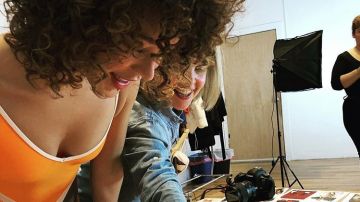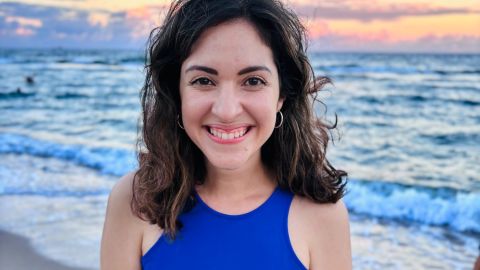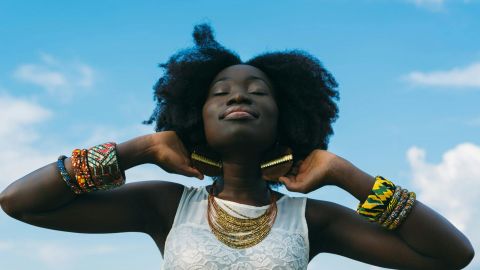This Latina Created a Smart Swimwear Line With Disfigurement in Mind
The thought of walking along the beaches of Costa Rica and wiggling your toes in the sand sounds like paradise for most people

Photo: Instagram/migaswimwear
The thought of walking along the beaches of Costa Rica and wiggling your toes in the sand sounds like paradise for most people. However, for designer Marialuisa Mendiola, it was a place of uneasiness due to her disfigurement. She remembers vividly being taunted in the eighth grade for her shortened fourth toes, (Brachymetatarsia) even recalling the “hyena-like” laughter from cruel middle school bullies. “Just like that I was outed. I could hear the talking behind my back, ‘[W]hy do her feet look like THAT?’ I could not wait for the trip to be over,” Mendiola said, adding that she frequently wore closed-toe shoes at the beach.
Now, Mendiola doesn’t want anyone else within the disfigurement community to feel the insecurity she’s felt at the beach, leading her to start Miga Swimwear via a Kickstarter on Wednesday, November 21, 2018.
She envisioned Miga Swimwear while in graduate school at the prestigious Central Saint Martins (designers Alexander McQueen and Stella McCartney are alumni) in order to spotlight those who have disfigurements, but deserve functional and on-trend swimwear too.
The brand’s name is a double entendre: firstly, translating to “crumb” in Spanish to symbolize the step-by-step process of building a business, and secondly, in Portuguese “miga” being slang for a female friend.
“Growing up when I would go to the beach, I would always look around to see if I could find feet that looked like mine,” she said. “I am hoping that through MIGA Swimwear, we can find ‘migas’ and feel less isolated and alone in our experience with disfigurement.”
Building that sisterhood, Mendiola used women’s stories and journeys that she met through the Burns Unit at NY-Presbyterian Hospital to design the pieces. For her graduate thesis project, (which is not for sale but highlighted in a Ravishly article) that meant creating designs inspired by the models’ scars reinterpreted into a pattern on the swimwear.
“I am extremely grateful for their participation as I know it takes a special kind of person that is willing to put themselves out of their comfort zone, trust a total stranger with their story, and believe in the impact the design process can have on coping with their visual difference,” Mendiola said.
So when Mendiola met Isabel Heine via the burn survivors support group at the Weill Cornell Medical Center, Mendiola’s interpretation of Heine’s story resulted in a brilliantly functional yet modern piece. “People in the disfigured community, just like anyone else, want to look stylish and feel sexy,” Mendiola said.
Heine, who experienced burns on 35 percent of her body in an apartment fire, must protect her skin grafts from sun exposure in order to keep them from becoming permanently darker, making the beach a challenging place. Before Miga Swimwear, that meant layering SPF-proof long-sleeve shirts and gloves over her two-pieces.
“Additionally, the scars make me pretty self-conscious as well as they draw unwanted attention. This has affected my happiness at the beach, a place I have always found joy,” Heine said. The final Heine-inspired piece is a chic navy blue, yellow, and baby blue colorblocked two-piece with a long-sleeve and SPF-50 fabric that protects her skin grafts, while giving her confidence at the beach. Even the asymmetrical designs and elements in Mendiola’s line connect to Miga’s body-positive mantra.

Photo by Bruna Lacerda

Photo by Bruna Lacerda

Photo by Bruna Lacerda
“This is not the first time I have used asymmetrical shapes in my designs as it reflects the asymmetry of the bodies that I work with. [A]nd by showcasing these differences, it helps us embrace it,” Mendiola said.
Through the collaborative process, Mendiola made sure her muses felt comfortable, by involving them not only in color swatches, fittings, and designs, but also making sure that their stories were told in the way they wanted it to be told. “She even drafted a short narrative of what she absorbed from our meeting…,” Heine said, which will be included on the bags. Although the brand’s focal point will always be the disfigured community, by including the stories it encourages all to shop the collection’s Kickstarter in order to build allyship.
The new line, which goes from XS to 3XL, will be priced at $95 for separates, and $180 to $330 for sets, is inspired by burn survivors, but will have a rotating theme centered around various disfigurements for subsequent collections. The 70s-inspired pieces aren’t just chic, but serve as a way to protect the skin from the strong UV rays thanks to SPF-50 fabric. If that wasn’t enough, the swimwear fabric is also recycled from fishnets!
Mendiola’s line is definitely part of a larger movement that is giving more visibility to the underserved disability and disfigurement market. More and more major brands are introducing adaptive components to their lines, such as Tommy Hilfiger, Zappos, and Target just to name a few.
Although those lines are mostly geared toward those with disabilities rather than disfigurements, the common thread is stylish and smart clothing that puts those communities in the spotlight. It speaks to representation and visibility on a larger scale too in the fashion industry, with Teen Vogue putting three supermodels with disabilities Chelsea Werner, Jillian Mercado, and Mama Cāx on the September 2018 cover (which is the most prestigious cover to land).
During New York Fashion Week, amputee and cancer survivor Cāx also appeared in Chromat’s Spring 2019 show, while activist and Breast Cancer survivor Ericka Hart boldly showed her double mastectomy scars on the runway. Also thanks to social media, models and influencers with disabilities and disfigurements are choosing how they want to be represented, and the tone of the discourse at large.
Mendiola’s line definitely acknowledges that, with each swimwear item including short prose on the bag centered around the model’s disfigurement. “I believe fashion design has the power to break the stigma of disfigurement because it can make something that is considered taboo [or] unwanted, into something cool and desired and that is where I want the disfigured and disability community to go,” Mendiola said.
When asked why she decided to launch a Kickstarter, Mendiola said it would be for both sustainability and community-building purposes. Miga Swimwear will only produce the quantity of pre-ordered pieces, while encouraging customers to serve as “backers” in order to build a thriving network of supporters. “More importantly, it will demonstrate that there is demand for a product that not only helps women feel more comfortable with their differences, but that is inspired by and showcases the stories of the disfigured community,” Mendiola said.
When asked about further plans for the brand, Mendiola plans to expand her brand into ready-to-wear, resort, and menswear. She also plans to utilize Miga Swimwear to give back to the community. “I also see the company having its own charitable arm that focuses on creating curriculums for school[s] on how to approach disfigurement, [and] workshops for how to cope with a change in appearance or with discrimination at work,” Mendiola said. So whether it’s putting on a swimsuit or walking barefoot on the beach, Miga Swimwear wants everyone to feel fearless on every shore.
Poem Included with bag (could be call-out):
Floating, left behind
I lose myself.
My arm, my hand, my arm
Feeling the sun on my face.
You never know how you are going to react,
Remember that.
Calmness, made it out
I lose myself.
When gasping for air,
When there isn’t enough
Look at my hand, there is nothing harder
than what I have already gone through.

















